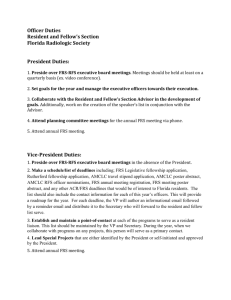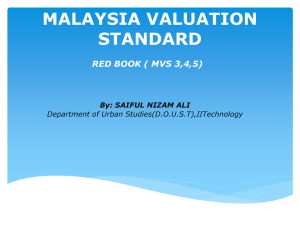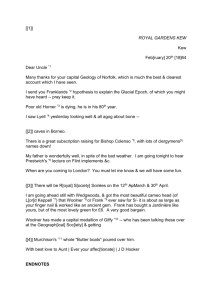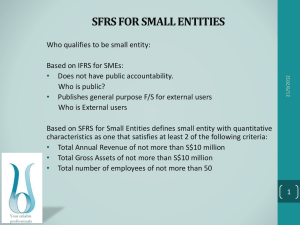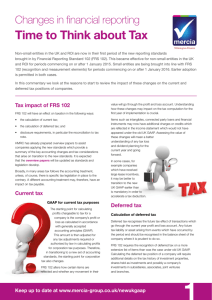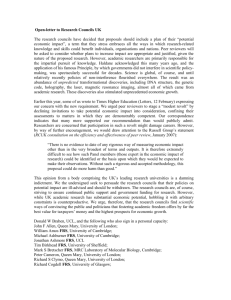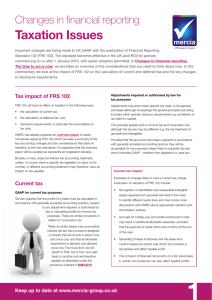ACCT224 Financial Reporting & Analysis
advertisement
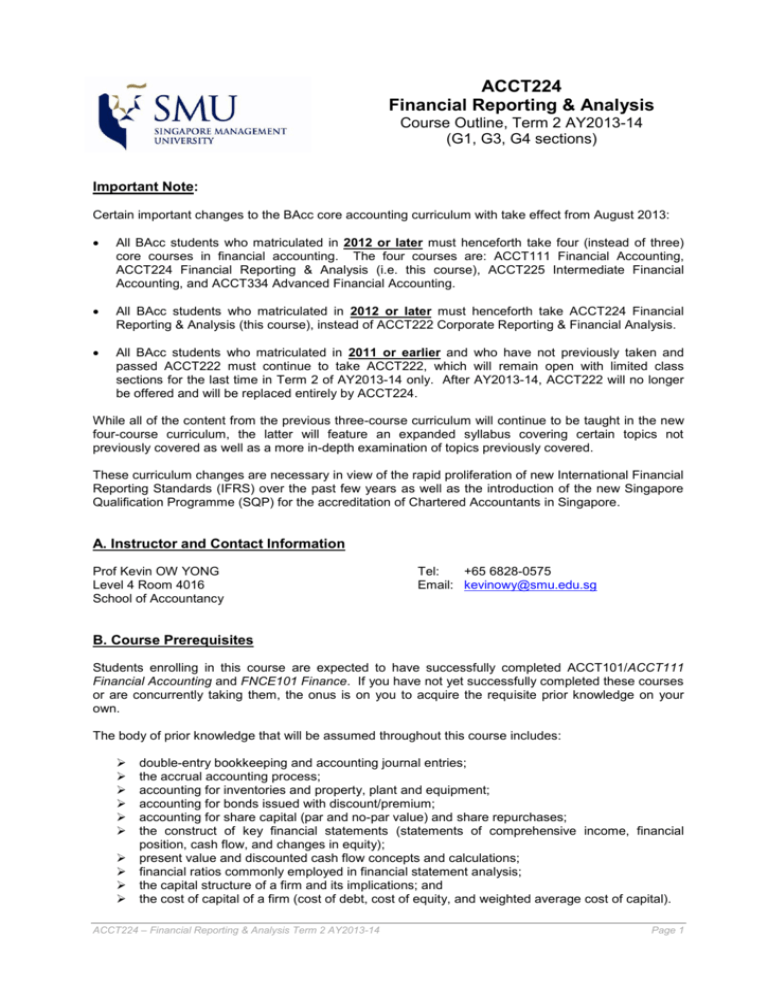
ACCT224 Financial Reporting & Analysis Course Outline, Term 2 AY2013-14 (G1, G3, G4 sections) Important Note: Certain important changes to the BAcc core accounting curriculum with take effect from August 2013: All BAcc students who matriculated in 2012 or later must henceforth take four (instead of three) core courses in financial accounting. The four courses are: ACCT111 Financial Accounting, ACCT224 Financial Reporting & Analysis (i.e. this course), ACCT225 Intermediate Financial Accounting, and ACCT334 Advanced Financial Accounting. All BAcc students who matriculated in 2012 or later must henceforth take ACCT224 Financial Reporting & Analysis (this course), instead of ACCT222 Corporate Reporting & Financial Analysis. All BAcc students who matriculated in 2011 or earlier and who have not previously taken and passed ACCT222 must continue to take ACCT222, which will remain open with limited class sections for the last time in Term 2 of AY2013-14 only. After AY2013-14, ACCT222 will no longer be offered and will be replaced entirely by ACCT224. While all of the content from the previous three-course curriculum will continue to be taught in the new four-course curriculum, the latter will feature an expanded syllabus covering certain topics not previously covered as well as a more in-depth examination of topics previously covered. These curriculum changes are necessary in view of the rapid proliferation of new International Financial Reporting Standards (IFRS) over the past few years as well as the introduction of the new Singapore Qualification Programme (SQP) for the accreditation of Chartered Accountants in Singapore. A. Instructor and Contact Information Prof Kevin OW YONG Level 4 Room 4016 School of Accountancy Tel: +65 6828-0575 Email: kevinowy@smu.edu.sg B. Course Prerequisites Students enrolling in this course are expected to have successfully completed ACCT101/ACCT111 Financial Accounting and FNCE101 Finance. If you have not yet successfully completed these courses or are concurrently taking them, the onus is on you to acquire the requisite prior knowledge on your own. The body of prior knowledge that will be assumed throughout this course includes: double-entry bookkeeping and accounting journal entries; the accrual accounting process; accounting for inventories and property, plant and equipment; accounting for bonds issued with discount/premium; accounting for share capital (par and no-par value) and share repurchases; the construct of key financial statements (statements of comprehensive income, financial position, cash flow, and changes in equity); present value and discounted cash flow concepts and calculations; financial ratios commonly employed in financial statement analysis; the capital structure of a firm and its implications; and the cost of capital of a firm (cost of debt, cost of equity, and weighted average cost of capital). ACCT224 – Financial Reporting & Analysis Term 2 AY2013-14 Page 1 C. Course Description This course provides an in-depth examination of corporate accounting issues and financial reporting standards as well as the analysis and interpretation of financial statements prepared under those standards. Particular emphasis will be given to the application and interpretation of Financial Reporting Standards (FRS) of Singapore. Topics covered include: financial reporting framework, presentation of financial statements, accounting standards and disclosure requirements, classification of income, quarterly reporting, segment reporting, changes in accounting policies and methods, accounting for non-current assets (including asset revaluation, assets held for sale, discontinued operations, investment property, biological assets, and intangible assets), impairment of assets, leases, provisions and contingencies, deferred tax, and revenue recognition. D. Learning Goals, Course Objectives and Skills Development This course contributes to the development of the following learning goals and objectives of the School’s Bachelor of Accountancy program: Learnng Goal 1 (Accounting Competencies): Learning Objective 1.1 – Our students can recognize, develop, measure, record, validate and communicate financial and other related information. Learning Objective 1.2 – Our students can analyze, synthesize and evaluate financial and other related information for decision making in a management context. At the end of this course, students are expected to be able to: 1. Identify, understand and apply the relevant financial reporting and disclosure principles and requirements for annual and interim reporting applicable to Singapore corporations. 2. Prepare a complete set of financial statements, with accompanying notes to accounts, in compliance with relevant financial reporting standards and disclosure requirements in Singapore. 3. Identify, understand and apply the relevant accounting principles and financial reporting standards applicable to Singapore corporations for the recognition, measurement, derecognition, presentation and disclosure of revenues, expenses, gains, losses, assets, liabilities and owners’ equity pertaining to more complex business transactions and events such as those involving changes in accounting policies and estimates, accounting errors, assets held for sale, discontinued operations, corporate restructuring, leases, provisions and contingencies, post-reporting-period events, asset revaluation, investment property, biological assets, intangible assets, impairment of assets, deferred tax, revenue recognition, construction contracts, and real estate sales. 4. Identify, understand and apply the relevant financial reporting standards and disclosure requirements applicable to Singapore corporations for segment reporting. 5. Understand the usefulness and limitations of alternative financial metrics, and know how to compute and apply them to evaluate a company’s operating performance and financial position. 6. Perform an in-depth analysis of a set of company financial statements, including making appropriate analytical adjustments thereto, in order to evaluate the company’s operating performance and financial position as well as assess its ability to service its financial obligations. Beyond just technical competencies, this course also seeks to develop your: analytical and communication skills; ability to work in teams; ability to engage in active learning; and awareness of ethical and social responsibility considerations in business decision making. ACCT224 – Financial Reporting & Analysis Term 2 AY2013-14 Page 2 E. Learning Approach The pedagogical approach to this course consists of: Instructor-facilitated Learning – principally through class lessons and class activities Individual Learning – through pre-class preparation, readings and homework Collaborative Learning – through participation in class discussions and teamwork in the project F. Textbook and Other Resources Recommended Text: Picker, Leo, Loftus, Wise, Clark and Alfredson, “Applying International Financial Reporting rd Standards,” 3 Edition (2013), John Wiley The text is available for purchase at SMU Booklink. Although this is a good text to have, I am not making this text compulsory. However, if you think that a text would help you learn and understand the subject better, I encourage you to purchase it. Other required course materials: Singapore Financial Reporting Standards (FRS), issued by the Accounting Standards Council (ASC) of Singapore – available on http://www.asc.gov.sg. A list of examinable FRSs, INT FRSs, and EDs to be covered in this course can be found in Annex 1. Relevant Singapore statutes – available on http://statutes.agc.gov.sg: Accounting Standards Act (Chapter 2B) Companies Act (Chapter 50) SGX Listing Manual (by the Singapore Exchange) – available on http://www.sgx.com. Other articles to be assigned during the term. G. Lesson Plan Classes are of three-hour duration per week. The following is a brief course schedule. A detailed lesson plan can be found in Annex 2. The Financial Reporting Environment Presentation and Disclosure of Financial Statements Accounting for Non-Current Assets Impairment of Assets Lease Accounting (by both Lessees and Lessors) Provisions, Contingencies, and Events after Reporting Period Evaluating Business Performance and Financial Position Credit Risk Analysis Revenue Recognition Employee Benefits and Retirement Benefit Plans H. Assessment Class Activities and Participation Two Quizzes (in-class, closed-book) Team Project Final Exam (closed-book, common across all sections) Total ACCT224 – Financial Reporting & Analysis Term 2 AY2013-14 15% 20% 15% 50% 100% Page 3 A brief description of each assessment component is provided below. requirements and criteria will be made known in class. Details of assessment Class Activities and Participation: Participation in class is a central part of the learning process for you and your classmates. When you participate and contribute in class, you help others learn and in the process you learn as well. You will be graded on class activities and participation on an individual basis. Such participation includes asking questions in class, answering questions (either voluntarily or when specifically called upon), contributing to class discussions in the form of ideas, thoughts, arguments, facts or opinions, and participating in any assigned class activities including any online discussion forums. Homework: You will be periodically assigned homework problems. These are for self-study and will not be graded. Suggested solutions will be provided. Some of the homework problems may be discussed in class. Progress Assessments: There will be two quizzes, both of which will be in-class, closed-book and non-cumulative. Details and format of each quiz will be announced in class closer the quiz date. Team Project: Team projects comprise of teams of four or five students each, all of whom should be enrolled for the same class section. Details on the project requirements will be announced during Week 3. Each team is to submit a written project report to me and be prepared to give a 15-minute presentation in class. Please do not assume that the project for this term would necessarily be similar to that for previous terms. University-recommended sanctions and penalties will be imposed for any plagiarism or academic integrity violation in this project. All project reports will be checked with plagiarism detection software. Final Exam: The final exam will be three-hour, closed-book, and cumulative. The exam will be common for all students regardless of which class section or instructor you are enrolled with. I. Academic Integrity All acts of academic dishonesty (including, but not limited to, plagiarism, cheating, fabrication, facilitation of acts of academic dishonesty by others, unauthorized possession of exam questions, or tampering with the academic work of other students) are serious offences. All work (whether oral or written) submitted for purposes of assessment must be the student’s own work. Penalties for violation of the policy range from zero marks for the component assessment to expulsion, depending on the nature of the offense. When in doubt, students should consult the instructors of the course. Details on the SMU Code of Academic Integrity may be accessed at http://www.smuscd.org/resources.html. By: Kevin Ow Yong, 18 December 2013 Approved by: Associate Dean, Seow Poh Sun, 24 December 2013 ACCT224 – Financial Reporting & Analysis Term 2 AY2013-14 Page 4 Annex 1: Singapore Financial Reporting Standards (FRS) Below is a list of FRSs, Interpretation FRSs (INT FRS), and Exposure Drafts (ED) which are required readings and will be examinable in this course. FRSs not previously covered in ACCT222 but now covered in ACCT224 are marked “new” below. Preface Framework Preface to Financial Reporting Standards The Conceptual Framework for Financial Reporting 2011 FRS 1 FRS 2 FRS 7 FRS 8 FRS 10 FRS 11 FRS 12 FRS 16 FRS 17 FRS 18 FRS 20 (new) FRS 23 FRS 34 FRS 36 FRS 37 FRS 38 FRS 40 FRS 41 (new) FRS 105 Presentation of Financial Statements Inventories Statement of Cash Flow Accounting Policies, Changes in Accounting Estimates and Errors Events after the Reporting Period Construction Contracts Income Taxes Property, Plant and Equipment Leases Revenue Accounting for Government Grants and Disclosure of Government Assistance Borrowing Costs Interim Financial Reporting Impairment of Assets Provisions, Contingent Liabilities and Contingent Assets Intangible Assets Investment Property Agriculture Non-current Assets Held for Sale and Discontinued Operations Implementation Guidance for FRS 105 Operating Segments Implementation Guidance for FRS 108 FRS 108 INT FRS 10 (new) INT FRS 15 INT FRS 27 INT FRS 31 INT FRS 32 INT FRS 101 INT FRS 104 INT FRS 110 INT FRS 112 (new) INT FRS 113 (new) INT FRS 115 Government Assistance – No Specific Relation to Operating Activities Operating Leases – Incentives Evaluating the Substance of Transactions Involving the Legal Form of a Lease Revenue – Barter Transactions Involving Advertising Services Intangible Assets – Web Site Costs Changes in Existing Decommissioning, Restoration and Similar Liabilities Determining whether an Arrangement contains a Lease Interim Financial Reporting and Impairment Service Concession Arrangements Customer Loyalty Programmes Agreements for the Construction of Real Estate Accompanying Note to INT FRS 115 ED/2013/6 Apr 2013 (new) ED/2011/6 Nov 2011 Leases (including Basis for Conclusions) Revenue from Contracts with Customers (including Basis for Conclusions) ACCT224 – Financial Reporting & Analysis Term 2 AY2013-14 Page 5 Annex 2: Detailed Lesson Plan This lesson plan may be subject to change as the term progresses. Weekly lesson materials will be posted on SMU eLearn a few days prior to the beginning of each course week. Week Topic Readings 1 The Financial Reporting Environment. Accounting Standards Act. Companies Act (s199-209B). 2 Presentation and Disclosure of Financial Statements. 3 The Moral Hazard/Principal-Agent Problem in Accounting. Promulgation of Accounting Standards – IASB, FASB, ASC. Objectives of Financial Reporting. Conceptual Framework for Financial Reporting. The Legislation of Accounting Standards in Singapore. Financial Disclosure Requirements under: – Companies Act. – Financial Reporting Standards (FRS). – Singapore Exchange (SGX) Listing Manual. SGX Quarterly Reporting Requirements. SGX Corporate Disclosure Policy. Format and Presentation of Financial Statements. Statement of Comprehensive Income. Interim and Year-to-date Financial Reporting. Prospective versus Retrospective Restatement of Accounting Numbers. Accounting Policies, Changes in Accounting Estimates, and Errors. Special, Exceptional, and Extraordinary Items. Segment Reporting. Accounting for Non-Current Assets. Property, Plant & Equipment under cost model (revision) Property, Plant & Equipment under revaluation model. Capitalization of Borrowing Costs. Non-Current Assets Held for Sale. Discontinued Operations. Investment Property. Biological Assets. De-recognition of assets and Recycling of Income. Intangible Assets. 4 SGX Listing Manual FRS 1. Amendment to FRS 1. FRS 7. FRS 8. FRS 34. FRS 108. FRS 16. FRS 23. FRS 105. INT FRS 32. FRS 20. FRS 38. Internally Developed vs. Purchased Intangibles. Research and Development Costs. Software Costs. Government Grants and Assistance. Impairment of Assets. FRS/Preface. Conceptual Framework 2011. FRS 36. INT FRS 32. Asset impairment – recognition and measurement. Concept of Cash-Generating Unit (CGU). Impairment of Cash-Generating Unit (CGU). ACCT224 – Financial Reporting & Analysis Term 2 AY2013-14 Page 6 Week Topic 5 QUIZ 1 (in-class, closed-book). Accounting for Leases. 6 Leases as rights-of-use. Finance Leases. Operating Leases and Incentives. Operating Leases as Off-Balance Sheet Debt. Sale and Leaseback Arrangements. Options on Leases. Accounting for Leases (cont’d). Lessor Accounting. Exposure Draft on Leases. Other Liabilities and Obligations. 7 Readings FRS 17. INT FRS 15. INT FRS 27. ED/2013/6 (Leases). FRS 17. INT FRS 15. INT FRS 27. ED/2013/6 (Leases). FRS 10. FRS 37. Provisions and Contingencies o Restructuring charges o Guarantees and Lawsuits o Contingent commitments Constructive Obligations. Events after the Reporting Period. Evaluating Corporate Performance & Financial Position. Business, Industry & Company Analysis. Balancing Business Risk and Financial Risk. Permanent vs. Transitory Earnings. Return on Capital. Alternative Earnings Measures – EBITDA, EBIT, Operating Profit, Operating Cash Flow, Free Cash Flow. Implications for Financial Analysis. 8 RECESS (No classes). 9 QUIZ 2 (in-class, closed-book). “Putting EBITDA in perspective”, Moody’s Investors Service, June 2000. Credit Risk Analysis. Assessing Debt Servicing Ability. Credit Ratings. Parental Support. Studies on Corporate Collapse. 10 Deferred Taxation. FRS 12. Accounting profit vs. Taxable profit. Current tax vs. Deferred tax. Tax base of an asset/liability. Taxable temporary differences & Deferred tax liability. Deductible temporary differences & Deferred tax asset. Special situations. ACCT224 – Financial Reporting & Analysis Term 2 AY2013-14 Page 7 Week Topic Readings 11 Revenue Recognition I. FRS 11. FRS 18. INT FRS 31. INT FRS 112. INT FRS 113. INT FRS 115. 12 Revenue Recognition under FRS 18. Customer loyalty programmes. Construction Contracts under FRS 11. o Percentage-of-completion versus Completed-Contracts Method. o Contract losses. Accounting for Real Estate Development and Sales in Singapore. Revenue Recognition II. Revenue Recognition under ED/2011/6. o Identifying separate performance obligations. o Determining transaction price. o Allocating transaction price to performance obligations. o Contract costs. o Onerous contracts. o Deferred, variable and contingent consideration. Applications of revenue recognition criteria under ED. 13 TEAM PROJECT PRESENTATIONS. 14 Self-Study (no classes). 15 Final Exam. ACCT224 – Financial Reporting & Analysis Term 2 AY2013-14 ED/2011/6 (Revenue from Contracts with Customers). Page 8

